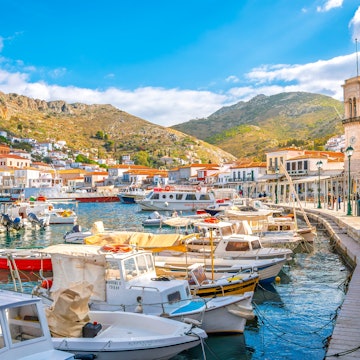
How to choose the best Greek Islands for your island-hopping itinerary

May 21, 2025 • 11 min read
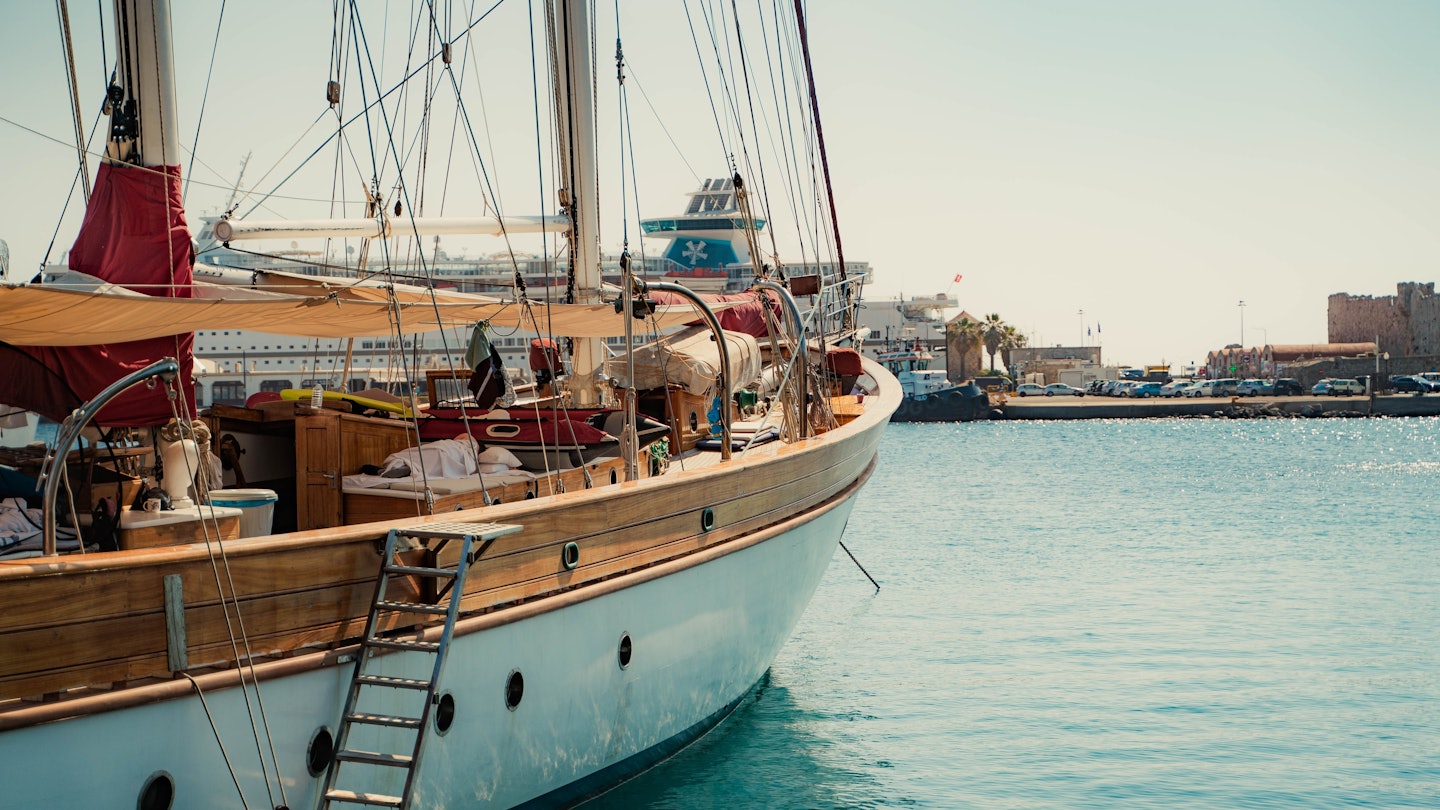
The port in the Old Town of Rhodes, a magnet for ferry-goers. JakWincenty/Shutterstock
So you’re planning to hit the Greek Islands and would like to hit more than one spot, but you’re not entirely sure where to go. Perhaps you’re looking to discover the “best” tiny beach cove in the Cyclades, or uncover archaeological treasures in the Dodecanese. And of course, wherever you venture, you intend to gorge yourself on local dishes and breathe in the aromas of wild herbs.
The beauty of any Greek island is that you really can have it all in one visit. The following island combinations allow ferry-hopping from one island to another in a couple of hours and give you intoxicatingly different travel experiences at both. Each of these happen to be within the same island groups (and are great links due to their close proximity and ferry services), but intergroup links are often possible, too.
Using ferries to plan your Greek island-hopping trip
First, a note before you plan: Greek ferries and hydrofoils change their schedules annually, and companies – and sometimes routes and island ports – may alter. The schedules are released around April (prior to Greek Easter) of each year. The most reliable websites include Ferryhopper and Greekferries; you can buy tickets from these sites, too. Services are reduced in low season or may not run at all. Prices mentioned below are also subject to change, due to seasonal demand.


Ionians: Corfu and Paxi
Recommended itinerary: 7-10 days
Corfu
The largest of the Ionian Islands, Corfu has it all: beaches, culture, food and action. Your first stop, Corfu Town, the island’s elegant capital, oozes charm. Get lost in its quaint pedestrian alleys that are lined with Venetian-style mansions, and emerge at the beautiful Liston Arcade. Watch the action along this busy promenade and then visit the must-see sights: the Corfu Museum of Asian Art and the Palaio Frourio. Then, catch a local bus and beach hop your way around the tiny coves of the west coast. Paleokastritsa, a tiny beach where Odysseus mythically washed ashore, has a gorgeous approach, through cypress and olive groves.
The east coast is a line of picturesque bays and cliffside vistas. At Kalami, enjoy lunch at the White House, a delightful waterfront restaurant with a vine-shaded terrace in the former home of writer Lawrence Durrell. Don’t miss the Achilleion Palace, 12km south of Corfu Town. Built in the 1890s for Austria’s empress Elisabeth, this summer palace has stunning garden terraces. If Corfu Town is too busy for you, head to the gorgeous hamlet of Kassiopi where the owners of Manessis Apartments epitomize filoxenia (hospitality).
Paxi
Paxi, a petite island measuring only 13km by 3km that offers a go-slow change from Corfu’s faster pace. Teal waters, neoclassical villas, beautiful quays speckled with yachts and olive groves are the main features. A visit here is about experiencing the vibe of yesteryear but with a strong whiff of expensive perfume; unlike parts of Corfu, accomodation errs toward the boutique and there’s no package tourism. (That said, places like the friendly San Giorgio Apartments in Gaïos are excellent value for their sea views and kitchenettes.)
Have a meal in any of three gorgeous port villages, Gaïos (Mambo is the pick here for traditional fare), Lakka (try Paxoimadi for its tradition-meets-contemporary approach) or Loggos (Vassilis restaurant for its creative menu). Then spend your days following the old stone walls within olive groves along former mule trails. Beaches here tend to be small pebble coves, although there are exceptions: jump on a boat to the tiny island of Antipaxi, where sandy Vrika Beach provides great opportunities for a plunge in crystal clear waters.
How to do it: At least eight high season ferries run between Corfu Town and Paxi (one hour/2½hr; US$40/17).
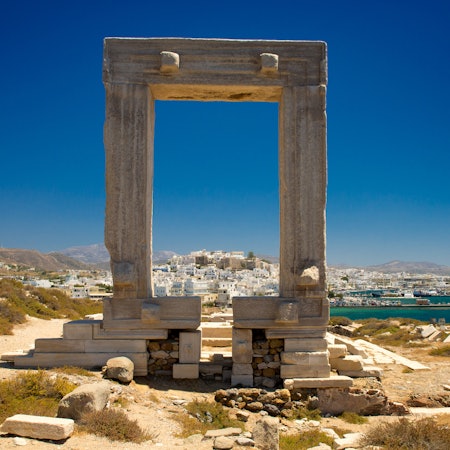

Cyclades: Naxos and Koufonisia
Recommended itinerary: 4-6 days
Naxos
The largest of the Cycladic chain, Naxos is an unpretentious spot. It attracts everyone from families to mature travelers to laze on great beaches, climb mountains and explore archaeological sites. Unlike other islands, Naxos has a working feel; its agricultural roots are reflected in its striking green interiors. You’ll pull into port at the beautiful Venetian capital, Hora (also called Naxos), an extraordinary web of alleys, lined with tourist shops and cafes and a hilltop kastro (castle).
For hospitable, family-friendly accommodation, Sofi Pension is a reliable option. For cuisine, don’t miss Doukato, especially for the Naxian specialty gouna, sun dried mackerel. Hit the west coast to windsurf, poke your head into the tiny inland Byzantine churches and wander through the quaint village of Halki in the Tragaea mountains.
Koufonisia
The smallest island of the inhabited Cyclades, Koufonisia, is a mere 50-minute boat trip from Naxos. And, although Naxos is non-fuss and kid-friendly fun, Koufonisia draws a supremely fashionable crowd: expect cosmopolitan restaurants and bars rather than traditional tavernas. (It’s worth splurging at Mikres Cyclades for the best of local produce, including Schinousa fava and Naxian cheese.) The same goes for accommodation, but for comfort:value ratio, Apollon Studios is recommended. The best spot for a swim is Pori Beach, or go nude further east beyond Finikas and Fanos beaches.
How to do it: At least eight high season ferries run between Naxos and Koufonisia (2hr 35min/40min; US$10/60).


Saronic: Hydra and Spetses
Recommended itinerary: 4-5 days
Hydra
The gorgeous (if arid) island of Hydra is famous for its lack of cars, its beautiful Venetian-style architecture and warren of lanes, and its resident artists, actors and bohemian types. Drop your bags at one of Hydra’s lovely guesthouses, such as Nereids, and then sit at any harborside cafe to enjoy the charms: tour touts, locals going about their daily business, and mules that transport people and baggage.
To give your backside a different kind of workout, mount a horse with Harriet Jarman and tour the monasteries and beaches of the island; a basic map is posted on the quay showing several marked trails. For watery adventures, rent a speedboat or boat ride or stretch your legs on some of the mule trails that criss-cross the island. After this, you’ll be ready for a carb loading of galaktoboureko (custard slice) and goats’ milk ice-cream, the renowned treats at Flora’s on Plateia Votsi. For a taste of culture, visit the Lazaros Koundouriotis Historical Mansion and the island’s 17th-century cathedral.
Spetses
Given its proximity, yet the marked contrast in geography and feel, it makes sense to head to Spetses, where lush foliage of pine forests cover its rolling hills. One main road rings the island, so jump aboard a scooter or e-bike to explore the stunning coastline and coves; bicycle hire places are prolific here.
Wander through Bouboulina’s Museum to understand the seagoing history and the captains’ mansions, legacies of the island’s rich naval history and shipbuilding background. Or jump aboard a local bus to catch some sun at the island’s beaches: Ayios Mamas, Ayia Paraskevi and Vrelos. For fine food? Seafood doesn’t come more outstanding than at Patralis in Spetses Town.
How to do it: Around five to six high-speed ferries head between Hydra and Spetses (35min; US$21).

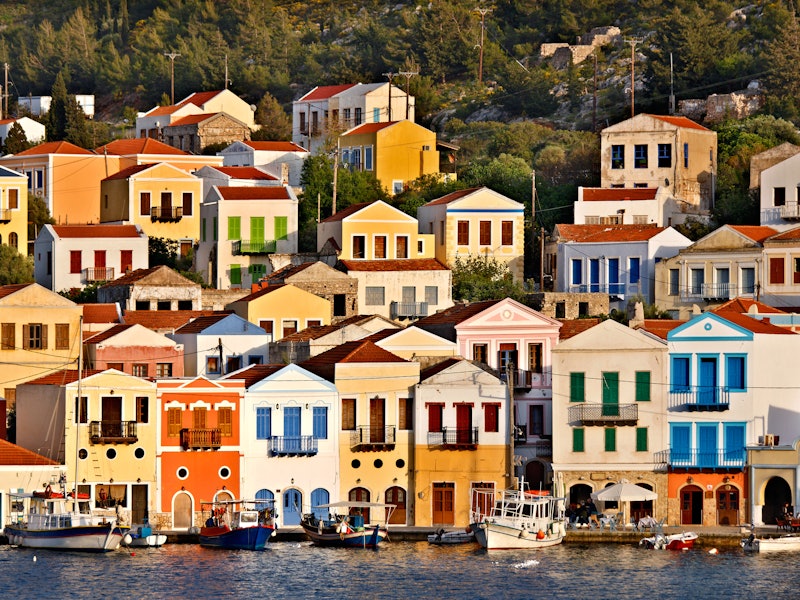
Dodecanese: Rhodes and Kastellorizo
Recommended itinerary: 5-7 days
Rhodes
The largest of the Dodecanese, Rhodes has everything: beaches, historical sites and nightlife. Rhodes’ Old Town is an extraordinary blend of Byzantine, Turkish and Italian architecture. It’s also a magnet for ferry goers and a ‘fun hub’ for all. Here you can opt for everything from budget hotels to boutique digs, tranquil parks to late-night bars, and gourmet seafood to Rhodian meals (for this, try 4 Rhodies, a local favorite).
Once you’ve ticked off the Old Towns’ cultural highlights – the Archaeological Museum, Street of the Knights and Palace of the Grand Master – jump on a local bus to the pretty village of Lindos. Then catch some rays on Pefki and Glystra beaches, or the stretch of pebbles and sand dunes from Gennadi to Plimmyri. Kitesurfers can jump waves on the windier Western Rhodes, while lovers of the outdoors can breathe in the scent of pine and visit castle ruins slightly inland.
Kastellorizo
Micro-sized Kastellorizo, just 2km from the Turkish coast, is the antithesis of Rhodes. A tiny strip of harbor known as the kordoni is the main and only village of this compact island, and it is lined with traditional pastel-painted neoclassical mansions that house boutique hotels and tavernas; there’s a definite price hike here. Mediterraneo is a sleeping option to splurge on.
What to do next? You will do little more than sip on an espresso in the morning, plunge into the waters off a platform (there are no beaches here), unwind the cats that have entwined themselves around your legs, and while away the time watching the world go by. If you can shake yourself out of your relaxed stupor, take a water taxi trip to the extraordinary Blue Cave, and hike up to Paleokastro, the island’s ancient capital. Then return for a leisurely meal at Bouzouki, one the best of Kastellorizo’s quayside options.
How to do it: Ferry connections between the two islands are limited to several weekly departures, so plan ahead and buy tickets in advance (2hr 20min/3½hr US$44/20).
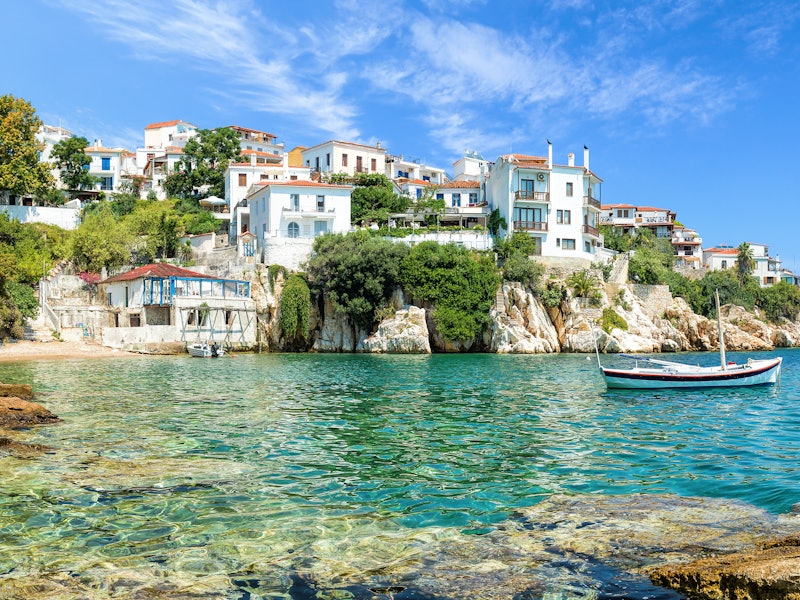

Sporades: Skiathos and Skopelos
Recommended itinerary: 5-6 days
Skiathos
The most accessible island in the Sporades, beautiful Skiathos is ringed with exquisite, sandy-white beaches and carpeted in olive trees and fragrant pines. Nevertheless, the holiday villas and lively bars make it one of the Sporades’ most cosmopolitan islands. For accommodation, Hotel Kostis is a cheerful budget choice. After exploring the harborfront and town boutiques, dine on superb seafood at Bakaliko. Next, for your fill of culture, wander through the Skiathitiko Spiti folk museum in Skiathos Town. The island’s diverse offerings include Parissis Winery and Moni Evangelistrias (where the first modern Greek flag was woven and raised).
For superb vistas and great bird watching, don’t miss the Kastro, Skiathos’ ruined medieval capital. For beaches, there are 60 or so to choose from. One of the most appealing? Koukounaries, a blissful 1200m-long sweep of fine, blond sand. Energetic souls will love the hiking trails; around 26 signposted routes are outlined in a local’s guidebook, Skiathos: Hiking in the Aegean Paradise.
Skopelos
From here, it’s a short jaunt to neighboring Skopelos but, given the island’s differences, it feels a million miles away. Unlike Skiathos, Skopelos is a larger island with a more sedate experience, albeit one with nightlife in its relaxed bars. The island is blessed with olive groves, pine forests, vineyards and orchards; thankfully, even the fact that Mamma Mia! was filmed here hasn’t diminished its charm. Beaches here are shingle or pebble beaches, but they are still beautiful – our favorites include Kastani, Limonanari and Panormos.
Alternatively, explore sea caves and deserted coves with Kayaking Greece. Discover dozens of monasteries and chapels, and hit one of many wildflower-flanked walking trails while breathing in the fragrance of wild thyme and sage. (Buy a copy of Skopelos Trails by Heather Parsons.) And don’t miss the peacock blue water at Cape Amarandos and the clifftop Agios Ioannis, the chapel of Mamma Mia! renown. Finally, gourmands can reserve a dining experience at Agnanti that whips up wonders with local organic produce.
How to do it: Regular services ply the route between Skiathos and Skopelos, and prices vary (15/30/50min; US$33/19/33).


North Aegean: Samos and Ikaria
Recommended itinerary: 5-7 days
Samos
Although located just off the coast Turkiye, and one of the northeastern Aegean Islands’ best known, Samos is a remarkably low-key island. The principal settlements of Vathy, the buzzying capital, plus Pythagorio, Karlovasi and Kokkari are all engaging in their own right. Pythagorio is home to ancient marvels including the archaeological site Heraion of Samos (birthplace of mathematician Pythagorus), whose origins stretch back to the 8th century BCE. The Archaeological Museum of Samos showcases finds from the site, including Greece’s largest standing kouros statue. Elsewhere, steep forested slopes and gorges and decent trails are perfect for hiking.
For guided walks, Samos Outdoors runs guided hikes, including through the gorgeous verdant mountain village Manolates. Sun-seekers can plonk on one of many beautiful shingle and sand beaches. For a change of scene, make your way around the mountain villages, including Vourliotes and Ambelos, and take a dip in the freshest of fresh Potami Waterfalls. And don’t miss a tour of the 1036m-long Evpalinos Tunnel, that was completed in 550 BCE and for 1000 years supplied Pythagorio’s population. Finish with a tipple of the local wine, Samian white muscat, at the island’s winemaking cooperative and Samos Wine Museum.
Ikaria
Ikaria, like Samos, is also very beautiful, with clear cerulean waters, lush landscapes, mountain ridges and waterfalls, and Cyclopic-size boulders atop hills. The difference here is the culture: known for their healthy lifestyle, friendliness and sociability, Ikarians are also famous for their longevity (100 is a frequently celebrated milestone). In the capital, Agios Kirykos, peruse the Archaeological Museum of Agios Kirykos to learn how islanders historically coped with years of pirate raids. Next, take your pick of many hot spring experiences. Those at Therma are a great start to soak in radon-rich waters; you can do boat tours here, too, to isolated coves and swimming spots.
Discover your own beach coves; beautiful Seychelles Beach is framed by rocks and its pebbles and vivid emerald waters, but it’s compact and fills quickly. Favored by naturists (nudists), Nas is another lovely spot. Wind your way to island villages: Akamatra, where you can sit in its gorgeous square that’s grounded by a 500-year-old oak tree; the tiny and fuss-free village of Karkinagri; and Manganitis, a gorgeous fishing village. For a healthy culinary treat, don’t miss trying the honey made with Ikaria’s prolific wildflowers and herbs.
How to do it: Daily high-season connections run between Samos and Ikaria (1½/2/3hr; US$23/7/10). Bus services on the island are limited, so it may be worth hiring a car or even a taxi.














